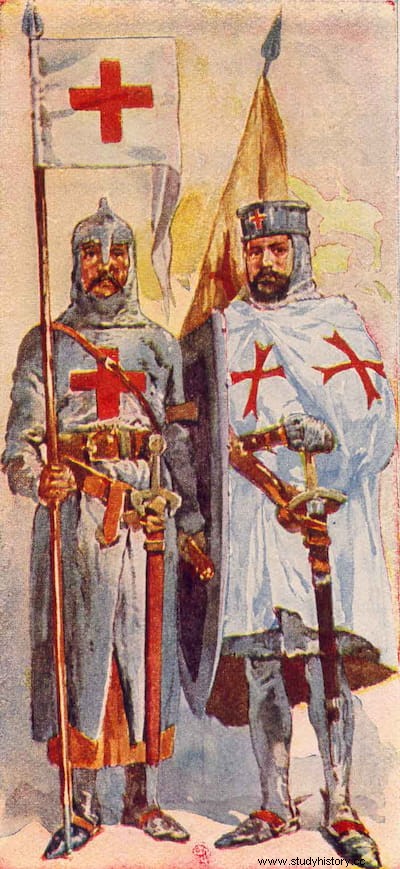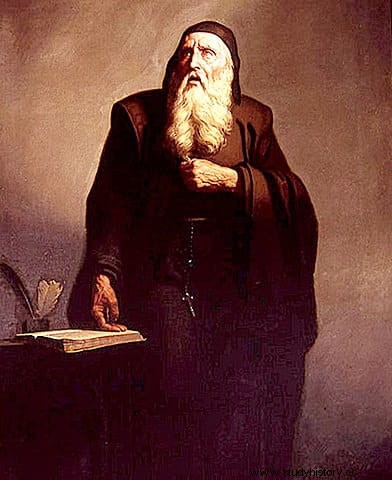On November 27, 1095, during the Clermont Council (France), the attendees experienced a mixture of surprise, stupefaction and enthusiasm upon hearing the unusual address of Pope Urban II . Although the Byzantine Emperor Alexios I Komnenos had launched a dramatic request for help in the face of the Muslim advance, nobody expected to hear that harangue that encouraged Christianity to take up arms to protect the faithful who traveled on pilgrimage to theHoly Places , which had recently fallen into the hands of an expanding Islam. Under the motto Deus vult (God wants it), criers and monks like Pedro the Hermit toured Europe proclaiming the crusade .
Princes, nobles and peasants responded to the call; The latter were the ones who the following year went to the East, to the Byzantine Empire, to stop the Seljuk Turks. In practice, that army that was identified with the Crusade of the Poor it became an uncontrollable horde advancing sowing destruction, murdering Jews and plundering, so the emperor shipped it directly to Turkey and there most were easily massacreed by the enemy .

Meanwhile, another army arrived in Constantinople, this one made up of knights, professional warriors very different in order and experience from their predecessors, known as the Crusade of the Barons . Aided by Alexius I, this troop was able to reach the Holy Land and conquer Jerusalem in 1099, taking over the entire Syrian-Palestinian strip over the next twelve years. Thus, despite the initial stumble, the First Crusade had been successfully completed. Now it was time to prepare to preserve what had been achieved in the face of the foreseeable Saracen reaction and the way to have a permanent force to do so in such a remote place was through chivalry orders .
Chivalry had reached its zenith in the Medieval despite the fact that it was inferior to that of other times in quantity and variety. This was due to their identification with the ruling class , to the establishment of a code of values ethical-religious that came to constitute an entire way of life and that was the de facto representation of the feudal system . But since the knights were lords of fiefdoms, principalities, kingdoms, and other types of territories, and had governing responsibilities to them, it was impossible for them to be permanently apart. The alternative was the creation of orders that combined the military aspect with the religious .
The first to appear was that of the Holy Sepulchre , followed by the Hospital of Saint John of Jerusalem , the Temple and the Teutonic . From there and over the centuries, a rosary of military orders was created that reached a hundred. The ones that interest us here are those mentioned, dedicated to protecting the Holy Land, because that region that the First Crusade had returned to Christian control could not be maintained and, after the failure of the successive following crusades (there were seven in total), it was ended up losing on May 18, 1291, when the last bastion, Acre, fell into the hands of Sultan Al-Ashraf Khalil. .
It was then that the system of military orders, whose atomization presented them as ineffective, and the idea arose of unifying them under a single command that should embody some notable of proven virtue, with a view to starting a reconquest. Of all the proposals that circulated at that time, the most studied and complete was the one elaborated by the famous Majorcan scholar Ramón Llull (whose seventh centenary of his death is celebrated this year), who developed it not as a concrete and explicit thesis but through several letters and three of his works, in which he baptized the concept with the name of Rex bellator (Warrior King).
Llull had already dealt with the subject of orders in his Book of the Order of Chivalry, in which he defined the knight as "chosen among a thousand" because of virtues such as “wisdom, charity, loyalty, truth, humility, fortitude, hope and others…” , just as his office was «to maintain and defend the Holy Catholic Faith» because «the god of glory has chosen knights who, by force of arms, defeat and seize the infidels who strive to destroy the church » . It is true that, as he grew older, Llull moderated his position until he became a friar and went as a missionary to the mosques, but he seemed to be the ideal person to tackle the issue.

The thing is, according to his plan, that Rex bellator , which should be free of family ties, would head a union of the military orders in which the most powerful, such as Hospitallers and Templars, would have greater weight. To this force would be added others of diverse origin, in the case of the peninsular orders and even the Almogavars, forming a great army that would be embarked on the ships of the Crown of Aragon to cross the Mediterranean and land in North Africa. At least that was the idea developed in two books:one, written in 1292 after the fall of Acre, was Quomodo Terra Sancta recuperari potes (How can the Holy Land be recovered), which he delivered to the college of cardinals assembled for the election of the new Pope after the death of Nicholas IV; the other was titled Liber de Fine and, once again, he composed it just after a military disaster, the loss of Arwad (an island off the Syrian coast) in 1302.
Unfortunately, not only the orders were each on their own. That second book by Llull, delivered to Pope Clement V in 1305, put the French on alert by giving so much prominence to the Aragonese of Jaime II, so in less than a year it was published in the neighboring country De recuperatione Terrae Sanctae (On the recovery of the Holy Land), signed Pierre Dubois , who proposed peace among all Christian nations, a reform of the military orders that would reduce their income, the formation of a body of linguists specialized in oriental languages (something copied from Llull) and, the most important difference with respect to Llull, the figure of King Philip IV of France as leader and sovereign of that western coalition. Rex pacis , he called it, instead of Rex bellator .
In fact, there was another reason for the French to have their own project and it was that the monarch had already been planning for some time how to get hold of the riches of the Temple and transfer ecclesiastical jurisdiction to the Gallic crown. He surely also weighed the rejection of his request to join the order , made after becoming a widower and imitating the intention of the son of Jaime II (which could thus be the Rex bellator ). And, indeed, shortly after (in 1307) a process was unleashed against the Templars involving multiple charges and leading to the death and/or imprisonment of many of them, as well as the dissolution of the order . Prince Jaime had to enter the Montesa.
Returning to Ramón Llull, although his plan had been approved by Boniface VIII, it was never put into practice because the pontiff did not want to risk leaving the power of Christianity in the hands of a temporal prince. But in 1309 he still dealt with the Rex bellator in a third work entitled Liber de Acquisitione Terrae Sanctae . Given the French reaction and the disappearance of the Order of the Temple, the new proposal was based on a double front in which Philip IV and the Hospitallers would advance towards the Holy Land passing through the Byzantine Empire while the Aragonese carried out the described plan of advancing along the African Mediterranean coast and cross Egypt.
For one reason or another, in the end none of those plans came to fruition . Felipe IV was satisfied with plundering the Temple while Jaime II focused on fighting Islam in the Iberian Peninsula with the -unsuccessful- conquest of Almería, so the idea of the Rex bellator It remained as a mere theoretical formulation and ended up forgotten. The Holy Places were never recovered and, over time, the Christians established there ended up at odds with each other until the status quo agreement was reached. from 1852.
